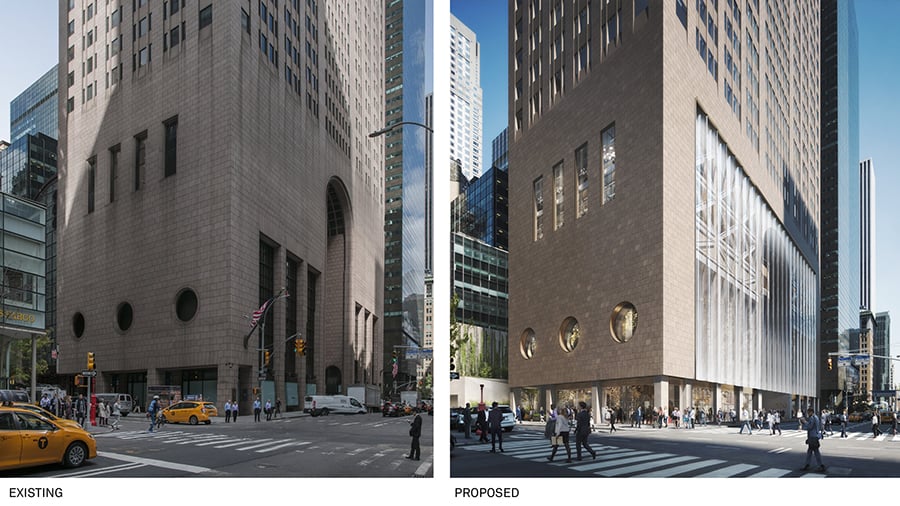
November 3, 2017
“Hands off My Johnson,” Say Architects and Preservationists at AT&T Building Redesign Protest
Robert A. M. Stern was among those protesting outside Philip Johnson’s Postmodern icon on Madison Avenue today.

[11/28/17 UPDATE: The New York City Landmarks Preservation Commission has calendared the AT&T Building, protecting it from alteration until the building is designated (or not designated) an official landmark.]
Today, a gaggle of protestors gathered outside the Philip Johnson and John Burgee–designed AT&T Building (formerly, the Sony Building and currently known as 550 Madison Avenue) to protest major changes to the skyscraper’s lower levels. The redesign, which was announced Monday, was commissioned by the building’s owner, Saudi investment firm Olayan America, and would be executed by New York and Oslo–based firm Snøhetta.
The protestors, who numbered around 20, gathered at 1 p.m. this afternoon in front of the building, bearing handmade signs that read, “Save AT&T,” “POMO Power,” and “Hands off my Johnson.”
Among the protestors were members of the preservation group DOCOMOMO, the Historic Districts Council, and a number of architects and advocates. Architect Robert A.M. Stern joined the rally at the urging of his architecture studio. “It’s one of the most important buildings of the last third of the century,” Stern told Metropolis. “After the Seagram Building, you basically have AT&T.”
Architectural significance aside, Johnson’s Postmodern icon has long been a lightning rod for criticism, though numerous design figures have rallied against the proposed changes, with Norman Foster and Adam Nathaniel Furman quickly voicing their support. Others, such as Denise Scott Brown, have suggested that the revamp has laudable features, such as an increase in public space. Though a New York fixture, the building is not landmarked, meaning Snøhetta’s proposed changes can be executed without a major review process. (Protestors are petitioning the New York City Landmarks Preservation Commission to intervene.)
Nathan Eddy, the filmmaker who organized the protest, told Metropolis, “I understand that a lot of people hate Philip Johnson and hate the AT&T building, but this building is historically important and should be preserved.” Eddy, who was born in the U.S. but is based in Berlin, makes films about endangered buildings including Prentice Women’s Hospital, and most recently, the James R. Thompson Center in Chicago. “As someone who is really good at rattling the chains of hoi polloi, this is a way I can contribute,” he said. “We’re going to win, by the way. But no matter what happens, if we get busy Manhattanites to look up and say, ‘Wow I’ve never noticed that building before’ and have an opinion about it, that’s the way forward.”
The redesign would leave the tower’s famous Chippendale top untouched, though the suggested modifications would come in two major areas: the first is the building’s Madison Avenue street front, which Snøhetta, in a press release, called “fortress-like” and “uninviting.” As per the architects’ design, the large glass facade would expose the building’s structure as well as its atrium, lobby, and first two levels.

The second major change, as seen in renderings, will come at the building’s covered mid-block passageway, which is located at the tower’s rear and connects 55th and 56th Streets. The glass arcade and an adjacent annex building will both be removed to create a “serene public space,” said Snøhetta. The architects added that this “lush outdoor garden will be the largest within a five-minute walking radius of the building, providing a respite from the verticality of Midtown.”
Speaking about the new proposal, Stern said, “It really ruins the building. If you take down the stone you have half a building. Half of the scheme would be destroyed.” Nonetheless, he conceded that “the street level has always had some problems, but this is not the solution to those problems.”
Asked if he had discussed the scheme with any member of Snøhetta, notably founding partner Craig Dykers, Stern said, “I don’t want to talk to him.” (Snøhetta had yet to comment at press time).

It’s worth noting that these won’t be the first proposed changes to the AT&T building, including earlier proposals by Stern himself. In the early 1990s, then-building owner Sony USA commissioned Gwathmey Siegel & Associates Architects to remake the building’s Madison Avenue street level, replacing a 60-foot-tall open-air arcade with retail space. (While it provided shade in the summer, the New York Times’s David W. Dunlap noted that the arcade typically “feels bleak, dank, noisy and windblown.”) Then, in 2013, the Chetrit Group had explored installing Stern-designed condominiums in the building’s upper floors (his proposal wouldn’t have altered the building’s exterior). However, those plans fell through when Chetrit sold the building Olayan America in 2016.
“We are all concerned about the fate of this building. It’s not something to be taken casually,” said Stern. “It really is a landmark. It hasn’t been designated a landmark, but it is a landmark for the city and for the history of architecture.”
You may also enjoy “Snøhetta Will Radically Remodel Philip Johnson’s AT&T Building in NYC.”








